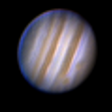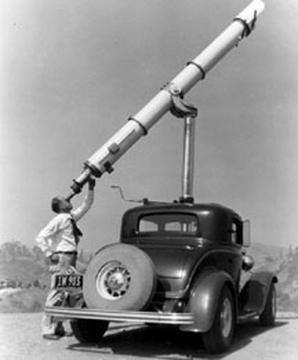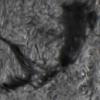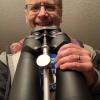
Interested in video astronomy - what equipment?
#26

Posted 10 February 2013 - 04:27 PM
As I mentioned in serveral posts in the past:
1. SONY Corp, Semiconductor division, does not openly sell pre-graded image sensors even to large cam/videocam/DSLR mfgs. Let along a tiny mfg.
Re: Research grade, that's out of character for SONY.
2. It does not means a downstream cam/videocam/DSLR mfg buy a batch then perform internal grading. Sometimes the top-tier mfgs sell back the ones they don't want to further downstream (smaller) cam mfgs.
3. Re: so claimed special packaging on ICX413, I am extremely skeptical. I know SONY quite well. Many, many years ago, I even visited their Central Lab as well as the close-guarded CCD fab. BTW, I even have their very early CCD Databook (printed version, PDF has not been invented. Some can even burst today's so-called patents. The old data already showed how the tricks were done!)
Since some of you already have that cam, why don't just take a front shot of the chip from the cam's opening and post a picture?
4. Videocam's Lux rating is totally useless. Don't waste time on it.
Clear Skies!
ccs_hello
#27

Posted 10 February 2013 - 04:54 PM
I agree with what you've posted. I'm not some Rock Mallin cheer leader but after watching him for a number of years and participating in the Yahoo group later on (and then also becoming a Mallincam customer) I'll offer a few observations.
In general Rock seems to prefer to design, build, sell, and use his video cameras rather than market them. He really lacks any visible product/lifecycle management (it might exist to some degree but isn't very visible). He seems to prefer to discuss the technology of his cameras rather than formally document many aspects (there's some real necessity here as many of his competitors would love to produce a similar product). The unfortunate result of this is that he's had many of the same conversations over and over again (for folks who haven't used the search capability ... lol). He was also very active on many of the sci.astro forums over the years, and some of this activity resulted in some really nasty flame wars ... but there isn't much about video technology that he doesn't know.
He is (as you've found out) very protective of his products and rightfully very proud of them. I believe he truly doesn't like to take an adversarial position but it seems that language and many folk's lack of technology understanding conspires to make some of the conversations difficult ... even when he's talking to folks who do have that background knowledge.
I've found that Rock remains available to answer just about any kind of question (via email, phone, or group posting), but his website only provides basic information so it can be a bit difficult to do your own research there. Reading through the old posts in the Yahoo group does also provide a wealth of information but there's a lot of "noise" covering up many of the nuggets of real in depth knowledge. His cameras are second to none and just about sell themselves but if you want some really in depth technical information you kinda have to work at it a bit.
It's not the way other folks might do it if they were in charge but I guess it is what it is.
#28

Posted 10 February 2013 - 05:28 PM
#29

Posted 11 February 2013 - 03:12 AM
4. Videocam's Lux rating is totally useless. Don't waste time on it.
Ok.
#30

Posted 11 February 2013 - 06:56 AM
Sony does have some research grade sensors available you just need to know who to deal with at Sony and their various distributors. They must be ordered through them.
Your statement is not entirely correct. I have spoken with and dealt with the master distributor for them and yes, they can get class 0 sensor. Oh, by the way,
let's clarify a few things here which you fail miserably at:
- There is no such thing as a class 0, class 1, class 2, class 3 etc in video ccd sensor. It is grade A, Grade B, Grade C etc. So, with astronomy related terminology, this translate to class 0, class 1, class 2 etc. We (MallinCam) stand correct on our claims for astronomical purpose not security type cameras. Huge difference. I am amazed that with all your claims and taking the time to slam down the MallinCam (you must hate Canadians) that you never stopped to think for a minute about such classification of true VIDEO ccd sensor. Not imager sensors.
Also, International agreements on sensor classification:
International Agreement is: 10 hot pixels or less at 2 seconds exposure equal class 1, with some column defect.
-MallinCam strict specification: 5 hot pixels or less for the same amount of exposure with ZERO column defect.
International Agreement on Class 0: 5 hot pixels or less at 2 seconds exposure with zero defect column.
- MallinCam Strict in lab specification: 3 hot pixels or less with ZERO column defect.
Don't ask me to tell you where I got these figures, Look it up. Look at popular specs of of sensors offered by various ccd imagers companies. I have charts here from Sony and other companies at hand to base ourselves on our method of offering the finest to any one interested in a MallinCam Video CD camera and we test every sensor before they go into a camera. Something you certainly do not do
We have a link posted on our website about research on ccd cameras , cooling etc. We are transparent in our camera for astronomical OBSERVATION. You fail short to make the difference between a astronomical imager and a live video ccd camera which is made to be a LIVE OBSERVING device, not a imager. Two complete different worlds. I stand correct about video ccd and my goal is for ccd Live Video Observation of Astronomical Targets, not imaging. It is clearly indicated on our website. We do this for advancement of astronomy not money. That too is indicated at the bottom of the page at:
http://mallincam.tripod.com/
It clearly states:
HANDCRAFTED IN CANADA FOR
THE ADVANCEMENT OF ASTRONOMY
NOT MONEY BY:
There is a section from the MallinCam Website that clearly show How It Is Made at:
http://mallincam.tripod.com/id22.html
We pay big bucks extra to bring in our sensors from Taiwan, the master distributor for Sony in which are hand delivered as seen in the link above. We are TRANSPARENT into our claims. We hand pick every ccd sensors in each and every cameras. Each camera is burnt-in for a period of 24 hours to ensure 110% quality using nothing but the best in the industry such as grade 1 electronics components.
It even shows that OUR SENORS are in fact class 0, class 1 etc because we order them through a shipper who offers manual inspection to avoid any X-RAY damages and exposure to extreme cosmic rays. It is shown on the website at:
http://mallincam.tripod.com/id22.html
Rock Mallin
MallinCam
PS: Why can't you show your professionalism if you have any and stop slamming down others. Your behavior is obviously questionable in every post on Cloudy Nights and elsewhere. Can we talks live video astronomy instead?
#31

Posted 11 February 2013 - 07:04 AM
You are correct. Therefore some basic LUX rating can be inaccurate due to optical figures used among other techniques.
We use the actual output of the ccd sensor to determine when the sensor does detect photons and translate this to voltage. We make sure we use our LUX rating based on CCD sensor registration among other specific scientific way ways as determined by the International System of Units (SI) and standards (ANSI FL1-2009) and other manufacturers of video ccd camera. There is a lot more to it than LUX. Electronics of the camera is equally important to the final LUX ratings.
Regards,
Rock Mallin
MallinCam
#32

Posted 11 February 2013 - 08:43 AM
I really appreciate the fact that you share your knowledge with others.
I am not sure that I fully understand "The difference between a astronomical imager and a live video ccd camera which is made to be a LIVE OBSERVING device, not a imager". Could you explain in your own words exactly what the difference is?
For example if I use the live view of a camera to output to a monitor, isn't it the same thing as using a dedicated "video camera"? In fact there is one camera(Olympus OMD EM5) that even allows you to manually set the update interval of the live view like the Mallincam.
Isn't this the same thing or am I missing something?
#33

Posted 11 February 2013 - 09:46 AM
Also, International agreements on sensor classification:
Rock Mallin
MallinCam
Please post a link to such "International agreements on sensor classification" . It would serve better to educate this forum than just vague assertions .
#34

Posted 11 February 2013 - 09:53 AM
Thank you for correcting my mistake. I now understand that Sony must be highly motivated to sell research grade sensors to a buyer who purchases about a couple hundred regular CCD's per year . That's what, $2,000 worth of ccd's from Sony per year . I am sure now and thanks again for pointing this out that for this amount of money Sony will make research grade or grade 0 or class a or whatever in the amount of 2 to 3 units per year for a special buyer. All one has to do is know the distributors. Makes sense .Matt,
Sony does have some research grade sensors available you just need to know who to deal with at Sony and their various distributors. They must be ordered through them.
Your statement is not entirely correct. I have spoken with and dealt with the master distributor for them and yes, they can get class 0 sensor.
Rock Mallin
MallinCam
#35

Posted 11 February 2013 - 10:11 AM
Matt,
Sony does have some research grade sensors available you just need to know who to deal with at Sony and their various distributors. They must be ordered through them.
Your statement is not entirely correct. I have spoken with and dealt with the master distributor for them and yes, they can get class 0 sensor.
Oh, by the way,
let's clarify a few things here which you fail miserably at:
- There is no such thing as a class 0, class 1, class 2, class 3 etc in video ccd sensor.
...
Also, International agreements on sensor classification:
International Agreement is: 10 hot pixels or less at 2 seconds exposure equal class 1, with some column defect.
-MallinCam strict specification: 5 hot pixels or less for the same amount of exposure with ZERO column defect.
International Agreement on Class 0: 5 hot pixels or less at 2 seconds exposure with zero defect column.
- MallinCam Strict in lab specification: 3 hot pixels or less with ZERO column defect.
...
We hand pick every ccd sensors in each and every cameras.
...
It even shows that OUR SENORS are in fact class 0, class 1 etc because we order them through a shipper who offers manual inspection to avoid any X-RAY damages and exposure to extreme cosmic rays. It is shown on the website at:
http://mallincam.tripod.com/id22.html
Rock Mallin
MallinCam
Let me see if I understood correctly what you just wrote:
- you buy research grade ccd's from Sony or their distributors, said ccd sensors being class 0.
- I failed miserably to understand that Sony class 0 ccd's don't exist (I thought that's exactly what I claimed, they don't exist, I don't see my failure ). Although you do claim you buy class 0 ???
- you have to hand pick your class 0 sensors from all the sensors you purchase , based on some criteria you set yourself , although you said you buy them as research grade or class 0 which you said doesn't exist???
- but although you hand pick them as class 0, you also bought them as class 0 because you know the disty ???
- you show how it's made on your website, where it shows a guy with a Dremel tool grinding/handcrafting one piece at a time on a dirty workbench corner some precision optics.
- the proof that you buy grade 0 CCD's is an illegible DHL shipping label on your website .
I am sorry if I seem confused, I tried my best to understand what you meant , let me know please if I succeeded.
#36

Posted 11 February 2013 - 10:24 AM
See now, you just proved my point about meaningless vague incomplete specifications .Also, International agreements on sensor classification:
International Agreement is: 10 hot pixels or less at 2 seconds exposure equal class 1, with some column defect.
-MallinCam strict specification: 5 hot pixels or less for the same amount of exposure with ZERO column defect.
International Agreement on Class 0: 5 hot pixels or less at 2 seconds exposure with zero defect column.
- MallinCam Strict in lab specification: 3 hot pixels or less with ZERO column defect.
Rock Mallin
MallinCam
Your X number of hot pixels at 2 seconds integration sounds great . But these numbers are meaningless due to :
- testing at different temperatures changes everything. You didn't specify the testing temperature.Is it 18C , is it 25C ? That difference more than doubles the dark current .
- what's the threshold at which a pixel is declared "hot". Is it hot when the well is filled 100% with dark current? Is it hot when it's filled at 90% ? When it's more than 3 sigma over other pixel values? What do you call a hot pixel in your own test which you just said is different from other vendors or alleged standards? Without explaining what you call a hot pixel, these claims are meaningless.
Also, the original thread was not meant to focus on these details but on the much simpler question of how could a camera in general , Mallincam was not mentioned , claim a million fold improvement in ccd sensitivity . Let's please stick to the original topic and please do not continue with attacking and insulting people who ask questions . Nobody called _you_ unprofessional , all people did was ask questions.
#37

Posted 11 February 2013 - 11:02 AM
Shalom Kasey
#38

Posted 11 February 2013 - 12:20 PM
Please don't play with words here ok? Don't patronize me. Your chewing against something you won't be able to handle.
End of conversation with you. Once again you demonstrate the lack of professionalism and knowledge in video ccd cameras for astronomical observation.
Matt, please, take the time re-read my post. I did not made the "TESTAMENT" that I buy ONLY scientific sensors. Go back and read my post to you. I clearly state (again) that Sony *does* make some scientific type grade sensors. You are obviously very limited in getting good contact with manufacturers and the industry. My post was direct at Sony making high grade and scientific type sensors. Go back and read again.
Why twist me wordings, Matt?
Man, Its got be a Canadian thing!
I am done lowering myself to your level, Matt. You discourage people in general in getting into live video ccd observation. You are not doing a favor to the astronomical industry and people who need live video ccd camera and related equipment to pursue their observing program. Other companies will be affected by your weak post infested with hatred against anyone who have an interest in live video observation, those who have visual problems and need video ccd to continue their live observations.
Rock Mallin
#39

Posted 11 February 2013 - 12:40 PM
A live video ccd is design and made to show the brightest dimmest object with the least amount of exposure live on a monitor for visual observation. A imager is made to take pictures. Huge difference.
Video has 30 FPS on average (29.970) and shows a image with some post processing bult in the camera to enhance the live image allowing a user to visually observe a faint target. They are not design to take pictures.
A imager will have some live monitoring but it lacks serious sensitivity. A video ccd camera will require a frame grabber to view live images on a computer. On a standard monitor, such device is not required.
For example, a MallinCam Xtreme will show images in 7 to 18 seconds with result that will rival images taken as a imager at 2 to 5 minutes exposure. That's what video ccd is for. Live visual observation with least amount of exposure. This translate in low periodic error showing up in a live image. Also a video ccd camera works at 100 duty cycle. a imager only works while taking a exposure. Electronics are not the same, sensors are not the same either. Image quality are good but again they are made for live observation not made to compete against high end ccd imagers.
MallinCam use CMYG type sensor instead of RGB. That's an increase in sensitivity above any RGB sensor. Also the mv output is higher on a video ccd sensor. Pixels are far bigger than a imager thus collecting more light. The bigger the pixels the brighter the image will be and the shorter the exposure needs to be. Video ccd camera such as the MallinCam is far and beyond more sensitive than any other imager out there for a reason: Live observing on a monitor with a computer and frame grabber or without any computer an frame grabber. Versatility is key here in live video ccd camera.
Hope this help understanding some basic differences.
Kindest Regards,
Rock Mallin
#40

Posted 11 February 2013 - 01:09 PM
I greatly appreciate your response. However, with all due respect, I don’t know if I agree with it. I don’t see the difference at all between plugging the monitor into the camera or plugging it into the Malincam. The camera may be designed to take good pictures but it also has live view output exactly like the Malincam does.
I fully understand that the Mallincam’s sensitivity is greater. However, I do question how much greater it really is. I am not basing that opinion on what I saw on Saturday at all. I fully admit that we set it up wrong and were not using it to its full potential. I am basing it on other images and integration times that everyone else has posted and my own images.
Is there any conversion between LUX and ISO? No one ever gives both measurements for a device.
I really want to complete a test between my new camera(Panasonic GH3) that I get back on Wednesday and the Extreme that Tony has. I really want to see the difference in sensitivity between the two on the exact same scope and outputting to the same monitor.
The field of views won’t be the exact same but my camera has a 2x loss-less crop mode that will get them to be at least similar. The extreme has a 1/2" chip in it, right? That is a 5.33x crop factor where mine is a 4x in crop mode.
Have you ever done a similar test with 1:1 results that you can show us?
What would be really cool is to do a NSN broadcast where we show the objects with the camera first and then switch to the Mallincam and show the same things. It appears that with Tony’s equipment and a hotspot we could do just that even from a semi dark location.
My goal is to validate your claim that "A MallinCam Xtreme will show images in 7 to 18 seconds with result that will rival images taken as a imager at 2 to 5 minutes exposure."
#41

Posted 11 February 2013 - 02:04 PM
Don't worry about image size. It's not *necessary* to crop the larger image at all; but of course it's easy enough to do.
Because the Mallincam has gain adjustment, you'll need to perform tests for at least the minimum and maximum settings of AGC. The impact on the image is quite marked. Indeed, if you're so inclined, you could conduct a series of exposures, exploring the relationship between AGC and required exposure to yield similar 'density' (a term from film technology), thereby establishing the range of gain in f/stops (and by extension, ISO ratio.)
#42

Posted 11 February 2013 - 02:48 PM
Travis,
Don't worry about image size. It's not *necessary* to crop the larger image at all; but of course it's easy enough to do.
Because the Mallincam has gain adjustment, you'll need to perform tests for at least the minimum and maximum settings of AGC. The impact on the image is quite marked. Indeed, if you're so inclined, you could conduct a series of exposures, exploring the relationship between AGC and required exposure to yield similar 'density' (a term from film technology), thereby establishing the range of gain in f/stops (and by extension, ISO ratio.)
That is what I plan on doing. First get the images to match in exposure and shutter duration. That should give me a base. For example the Mallincam might be AGC = 1 and my camera might be ISO 6400 if the Mallincam is that much more sensitive. Then I can increase the camera and Mallincam 1 stop each to see if those stops coincide with each other. If they don't then I will find out what their relationship is. For example 1 stop Mallincam might equal 2 stops camera.
Then finally I will test both at their maximum settings to see how much noise is present and also to see how dynamic range decreases with increases in gain.
#43

Posted 11 February 2013 - 03:56 PM
#44

Posted 11 February 2013 - 04:19 PM
I respect your opinion. LUX and ISO are two different measurements for each type of cameras. As stated before, MallinCam is strictly a live visual video ccd camera not a imager. Taking pictures with a MallinCam Xtrme, VSS or MCHP will never reveal anything close to what is seen live on a monitor. You are asking me to compare apples with oranges which is not my intention to do. Our products are not imager or DSLR. Not the same league at all. Does your camara use a CMOS or CCD?. That alone can't compare with one another. Electronics in each camera is made for a totally different application. Yours is a imager with video mode but is far to be a full video ccd camera. Probably your camera use a CMOS. We use high grade ccd sensors. No comparison.
I have proven several times in the past 10 years on several lists about the exposure comparison. I am not alone either. Many have posted similar images and of course the MallinCamhave won hands down when it comes fo shear sensitivity for live observing.
How about trying Hickson 50 galaxy group? I did it in 12 seconds exposure. That's a magnitude 20.0+ galaxy in a 5 galaxy group. Jack Huerkamp did it in 2.1 seconds with a MallinCam. Can your do the same?
Here's Jack Image of Hickson 50 at 2.1 seconds using a MallinCam-EXview HAD monochrome back in 2005:
http://mallincam.tri...s/hickson50j...
here's another taken by me with a 10" SCT live on Yahoo Live back in 2008 from downtown Ottawa under 3.0 magnitude sky.
http://mallincam.tri...tures/h50xw.jpg
here's another of Hickson 50 taken from Foymount. Exposure is 12 seconds. All images are frame grabbed not digital like your camera. Huge difference. This is for live observing obviously.
http://mallincam.tri...res/h50_w16.jpg
All images are documented on our website over the past 10 years.
Want comparison, I found this on the web: this is icing on the cake, here's a image of Hickson 50 taken with a 25" telescope, 30 MINUTES exposure, and a SBIG camera. You be the judge. This image is guided. All MallinCam images are taken in ALT-AZ unguided.
Let me know if you can reach such low magnitude within these specs with your camera. I would be very curious to see it. Dr.Simon Hanmer did it too using a LX 200 8" at 6 seconds exposure at Foymount back in 2006. He saw all 5 components of Hickson 50. In fact 15+ people all saw it on his monitor live during the Video Star party I organize every year.
Everything is on line for you to see or any one to see it. I don't need to justify myself to anyone about sensitivity and out cameras, we did tons of test where I purchased and still have just about all popular camera made. I buy them to test against our own. At least I invest money to make sure we have the finest as far as sensitivity is concerned. Part of quality program we have at MallinCam, part of customer satisfaction and part or research and development I have going.
Hope these images will convinced you otherwise about sensitivity and true live observation of celestial object with a video ccd camera.
Kindest Regards,
Rock Mallin
MallinCam
#45

Posted 11 February 2013 - 04:23 PM
Forgot the link for Hickson 50 with the 25" telescope, 30 minute exposure guided and SBIG camera:
http://www.dansdobim...son50_image.htm
My apology.
Rock Mallin
#46

Posted 11 February 2013 - 04:47 PM
Yes I have seen those images and they are simply astounding. Certainly I am not going to be able to see those in 2.5 seconds with my camera on my equipment. However, I am not going to be able to see them on my equipment with a Mallincam either.
I am not running anywhere near those focal ratios and I definitely don’t have the focal length to see details in small objects. You can't compare two cameras on completely different scopes. The comparison is only fair when the only variable is the camera.
What I want to see is exactly how much more sensitive is the Mallincam when used on the same equipment.
Your claims are based on sound reasoning. However, they make a lot of assumptions. They assume that all “Imaging” cameras can only take images. They can do that and a lot more than you realize. The still camera market has advanced a lot in the last few years and most people have no idea about that.
The manufactures have put features in their cameras like live view that refreshes every few seconds but continues to integrate. Both the Olympus and the Panasonic cameras now have RAW stacking in camera as well.
The biggest issue is that your's and many other people’s impression of “DSLR for AP” is based solely off of what the Canon cameras can do. They are not the end all be all of interchangeable lens cameras. Canon has rested on its reputation for about half a decade now and other companies have caught up and in some rare cases even surpassed what the Canon cameras are capable of.
You say that it is not fair to compare the live view from the interchangeable lens camera to the Mallincam. I still do not understand this. Both cameras are capable of outputting an NTSC 480i signal of a near real time video feed. When looking at the monitor the video feed will appear indistinguishable.
I know that the only way to prove this is to demonstrate how both cameras operate with the exact same equipment. Recording the video feed from both devices in the same manner should be sufficient evidence.
#47

Posted 11 February 2013 - 04:50 PM
Just for you. Some reading material. If its on the internet, must be the gospel truth.
http://en.wikipedia.org/wiki/Lux
As for sensor classification why don't you ask SBIG, Starlight Exress and many others? They post their specs we post ours. Look it up, its on the internet.
Have fun
Rock Mallin
#48

Posted 11 February 2013 - 04:55 PM
#49

Posted 11 February 2013 - 05:05 PM
Not that I know of. But here some basic info on Hickson catalog. Hickson 50 is beyond most amateur range. Awesome visual chalenge when using a video ccd camera. I love deep sky stuff, they are my favorites. I can;t get enough of it.
Some Hickson do have teir galaxies with some NGC numbers but not sure at the moment which. Hiskcon 50 is the ultimate.
http://en.wikipedia....n_Compact_Group
Regards,
Rock M.
#50

Posted 11 February 2013 - 06:10 PM
Hi A___L,
You are correct. Therefore some basic LUX rating can be inaccurate due to optical figures used among other techniques.
We use the actual output of the ccd sensor to determine when the sensor does detect photons and translate this to voltage. We make sure we use our LUX rating based on CCD sensor registration among other specific scientific way ways as determined by the International System of Units (SI) and standards (ANSI FL1-2009) .
...
Regards,
Rock Mallin
MallinCam
Rock, you must be kidding . Your cameras are more sensitive because you are using Le Système international d'unités in which way ?
The other standard you quoted is a great FLASH LIGHT standard. Some flashlight makers got together and decided to test their flashlights based on some common definitions and methods. Is your camera LED now regarded as a flashlight , or are you using a flashlight to test your cameras , or in which way is that ANSI flashlight standard relevant to your camera hot pixel or sensitivity specifications ?

























